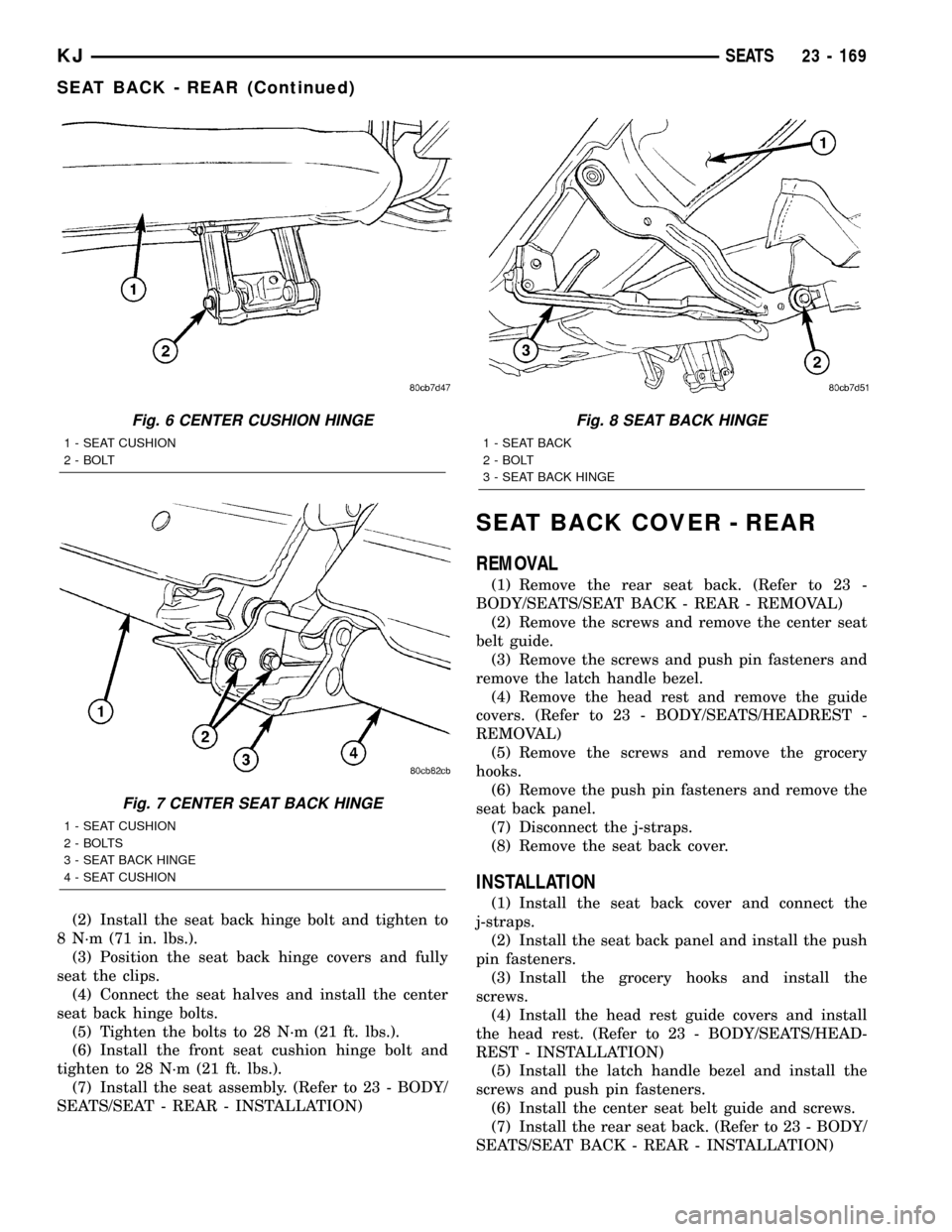2002 JEEP LIBERTY remove seats
[x] Cancel search: remove seatsPage 1632 of 1803

INSTALLATION
(1) Partially install the seat back cover and
replace the two top hog rings.
(2) Pull cover down and replace the two lower hog
rings.
(3) Connect the j-straps.
(4) Install trim caps and the head rest. (Refer to
23 - BODY/SEATS/HEADREST - INSTALLATION)
(5) Install the seat back. (Refer to 23 - BODY/
SEATS/SEAT BACK - FRONT - INSTALLATION)
SEAT BACK CUSHION - FRONT
REMOVAL
(1) Remove the seat back cover. (Refer to 23 -
BODY/SEATS/SEAT BACK COVER - FRONT -
REMOVAL)
(2) Separate the cushion from the seat back frame.
INSTALLATION
(1) Position the cushion onto the seat back frame.
(2) Install the seat back cover. (Refer to 23 -
BODY/SEATS/SEAT BACK COVER - FRONT -
INSTALLATION)
SEAT CUSHION - FRONT
REMOVAL
(1) Remove the seat back. (Refer to 23 - BODY/
SEATS/SEAT BACK - FRONT - REMOVAL)
(2) Remove the two outer front track bolts and
remove the track.
INSTALLATION
(1) Install the seat cushion onto the seat track
assembly and install the front two bolts.
(2) Tighten the bolts to 28 N´m (21 ft. lbs.).
(3) Install the seat back. (Refer to 23 - BODY/
SEATS/SEAT BACK - FRONT - INSTALLATION)
SEAT CUSHION COVER -
FRONT
REMOVAL
(1) Remove the seat cushion. (Refer to 23 - BODY/
SEATS/SEAT CUSHION - FRONT - REMOVAL)
(2) Disconnect the j-straps.
(3) Remove the hog rings and remove the cushion
cover.
INSTALLATION
(1) Position the seat cushion cover and install new
hog rings.
(2) Connect the j-straps.
(3) Install the seat cushion. (Refer to 23 - BODY/
SEATS/SEAT CUSHION - FRONT - INSTALLA-
TION)
SEAT CUSHION SIDE SHIELDS
REMOVAL
(1) Remove the screw and remove the recliner han-
dle.
(2) Remove the screws and remove the seat side
shields.
INSTALLATION
(1) Install the shields and install the screws.
(2) Install the recliner handle and install the
screw.
MANUAL SEAT RISER
REMOVAL
(1) Remove the seat. (Refer to 23 - BODY/SEATS/
SEAT - FRONT - REMOVAL)
(2) Remove the bolts and remove the rivet from
the release handle. (Fig. 4)
(3) Remove the riser.
Fig. 4 FRONT SEAT RISER
1 - BOLTS (3)
2 - SEAT CUSHION
3 - SEAT TRACK
4 - SEAT RISER
KJSEATS 23 - 167
SEAT BACK COVER - FRONT (Continued)
Page 1633 of 1803

INSTALLATION
(1) Install the seat riser and install the bolts.
(2) Tighten the bolts to 28 N´m (21 ft. lbs.).
(3) Install a new release handle rivet.
(4) Install the seat. (Refer to 23 - BODY/SEATS/
SEAT - FRONT - INSTALLATION)
SEAT TRACK
REMOVAL
(1) Remove the seat back. (Refer to 23 - BODY/
SEATS/SEAT BACK - FRONT - REMOVAL)
(2) Remove the outer riser. (Refer to 23 - BODY/
SEATS/SEAT RISER - REMOVAL)
(3) Remove the front outer bolts and remove the
tracks.
INSTALLATION
(1) Install the seat track onto the seat cushion and
install the front outer bolts.
(2) Tighten the bolts to 28 N´m (21 ft. lbs.).
(3) Install the seat riser. (Refer to 23 - BODY/
SEATS/SEAT RISER - INSTALLATION)
(4) Install the seat back. (Refer to 23 - BODY/
SEATS/SEAT BACK - FRONT - INSTALLATION)
SEAT - REAR
REMOVAL
(1) Remove the outer seat belt anchors. (Refer to 8
- ELECTRICAL/RESTRAINTS/SEAT BELT &
RETRACTOR - REMOVAL)
(2) Remove the inner seat belt buckles. (Refer to 8
- ELECTRICAL/RESTRAINTS/SEAT BELT BUCKLE
- REMOVAL)
(3) Remove the center seat belt anchor. (Refer to 8
- ELECTRICAL/RESTRAINTS/SEAT BELT &
RETRACTOR - REMOVAL)
(4) Remove the front bolts and nuts. (Fig. 5)
(5) Fold down the seat backs and remove the seat
assembly through the rear door.
INSTALLATION
(1) Install the seat assembly and position over the
studs.
(2) Open the seat back and engage the latches
onto the latch strikers.
(3) Install the rear outboard nuts and tighten to
43 N´m (32 ft. lbs.).
(4) Install the outer seat belt anchors. (Refer to 8 -
ELECTRICAL/RESTRAINTS/SEAT BELT &
RETRACTOR - INSTALLATION)(5) Install the inner seat belt buckles. (Refer to 8 -
ELECTRICAL/RESTRAINTS/SEAT BELT BUCKLE -
INSTALLATION)
(6) Install the center seat belt anchor. (Refer to 8 -
ELECTRICAL/RESTRAINTS/SEAT BELT &
RETRACTOR - INSTALLATION)
(7) Install the front outer seat cushion leg bolts
and tighten to 35 N´m (26 ft. lbs.)
SEAT BACK - REAR
REMOVAL
(1) Remove the seat assembly. (Refer to 23 -
BODY/SEATS/SEAT - REAR - REMOVAL)
(2) Remove the front seat cushion hinge bolt. (Fig.
6)
(3) Remove the center seat back hinge bolts and
separate the rear seat assembly. (Fig. 7)
(4) Release the clips and remove the seat back
hinge covers.
(5) Lift the seat cushion cover and remove the
hinge bolts. (Fig. 8)
(6) Remove the seat back.
INSTALLATION
(1) Install the seat back.
Fig. 5 REAR SEAT ASSEMBLY
1 - SEAT BELT ANCHOR BOLTS
2 - BELT BUCKLES
3 - BELT BUCKLE
4 - SEAT BELT ANCHOR BOLTS
5 - REAR SEAT ASSEMBLY
6 - SEAT BELT ANCHOR
7 - FLOOR PAN
8 - STUDS
9 - CENTER SEAT BELT
10 - FRONT STUDS
11 - NUTS (2)
12 - SEAT BELT ANCHOR
23 - 168 SEATSKJ
MANUAL SEAT RISER (Continued)
Page 1634 of 1803

(2) Install the seat back hinge bolt and tighten to
8 N´m (71 in. lbs.).
(3) Position the seat back hinge covers and fully
seat the clips.
(4) Connect the seat halves and install the center
seat back hinge bolts.
(5) Tighten the bolts to 28 N´m (21 ft. lbs.).
(6) Install the front seat cushion hinge bolt and
tighten to 28 N´m (21 ft. lbs.).
(7) Install the seat assembly. (Refer to 23 - BODY/
SEATS/SEAT - REAR - INSTALLATION)
SEAT BACK COVER - REAR
REMOVAL
(1) Remove the rear seat back. (Refer to 23 -
BODY/SEATS/SEAT BACK - REAR - REMOVAL)
(2) Remove the screws and remove the center seat
belt guide.
(3) Remove the screws and push pin fasteners and
remove the latch handle bezel.
(4) Remove the head rest and remove the guide
covers. (Refer to 23 - BODY/SEATS/HEADREST -
REMOVAL)
(5) Remove the screws and remove the grocery
hooks.
(6) Remove the push pin fasteners and remove the
seat back panel.
(7) Disconnect the j-straps.
(8) Remove the seat back cover.
INSTALLATION
(1) Install the seat back cover and connect the
j-straps.
(2) Install the seat back panel and install the push
pin fasteners.
(3) Install the grocery hooks and install the
screws.
(4) Install the head rest guide covers and install
the head rest. (Refer to 23 - BODY/SEATS/HEAD-
REST - INSTALLATION)
(5) Install the latch handle bezel and install the
screws and push pin fasteners.
(6) Install the center seat belt guide and screws.
(7) Install the rear seat back. (Refer to 23 - BODY/
SEATS/SEAT BACK - REAR - INSTALLATION)
Fig. 6 CENTER CUSHION HINGE
1 - SEAT CUSHION
2 - BOLT
Fig. 7 CENTER SEAT BACK HINGE
1 - SEAT CUSHION
2 - BOLTS
3 - SEAT BACK HINGE
4 - SEAT CUSHION
Fig. 8 SEAT BACK HINGE
1 - SEAT BACK
2 - BOLT
3 - SEAT BACK HINGE
KJSEATS 23 - 169
SEAT BACK - REAR (Continued)
Page 1635 of 1803

SEAT BACK CUSHION - REAR
REMOVAL
(1) Remove the seat back cover. (Refer to 23 -
BODY/SEATS/SEAT BACK COVER - REAR -
REMOVAL)
(2) Separate the cushion from the seat back frame.
INSTALLATION
(1) Position the seat back cushion onto the seat
back frame.
(2) Install the seat back cover. (Refer to 23 -
BODY/SEATS/SEAT BACK COVER - REAR -
INSTALLATION)
FOLDING REAR SEAT BACK
LATCH / LOCK
REMOVAL
(1) Remove the rear seat back cushion. (Refer to
23 - BODY/SEATS/SEAT BACK CUSHION / COVER
- REAR - REMOVAL)
(2) Disconnect the shoulder belt release cable. (Fig.
9)
(3) Remove the bolts and remove the latch/lock
assembly. (Fig. 10)
INSTALLATION
(1) Install the latch/lock assembly and install the
bolts.
(2) Tighten the bolts to 28 N´m (21 ft. lbs.).
(3) Connect the shoulder belt release cable.
(4) Install the rear seat back cushion. (Refer to 23
- BODY/SEATS/SEAT BACK CUSHION / COVER -
REAR - INSTALLATION)
REAR SEAT BACK LATCH
STRIKER
REMOVAL
(1) Remove the quarter trim panel. (Refer to 23 -
BODY/INTERIOR/QUARTER TRIM PANEL -
REMOVAL)
(2) Remove the bolts and remove the striker. (Fig.
11 )
Fig. 9 Seat Back Latch Cable Disengage/Engage
1 - LEVER
2 - PLUNGER
3 - LATCH CABLE FITTING
4 - REAR CENTER RETRACTOR
5 - SUPPORT
Fig. 10 LATCH/LOCK ASSEMBLY
1 - LATCH/LOCK ASSEMBLY
2 - SEAT BELT RETRACTOR
3 - RETRACTOR RELEASE CABLE
4 - BOLTS
5 - REAR SEAT BACK FRAME
23 - 170 SEATSKJ
Page 1636 of 1803

INSTALLATION
(1) Position the striker and install the bolts.
(2) Tighten the bolts to 35 N´m (26 ft. lbs.).
(3) Install the quarter trim panel. (Refer to 23 -
BODY/INTERIOR/QUARTER TRIM PANEL -
INSTALLATION)
SEAT BACK FRAME - REAR
REMOVAL
(1) Remove the center seat belt retractor, if
equipped. (Refer to 8 - ELECTRICAL/RESTRAINTS/
SEAT BELT & RETRACTOR - REMOVAL)
(2) Remove the seat back latch/lock assembly.
(Refer to 23 - BODY/SEATS/FOLDING REAR SEAT
BACK LATCH / LOCK - REMOVAL)
INSTALLATION
(1) Install the seat back latch/lock assembly. (Refer
to 23 - BODY/SEATS/FOLDING REAR SEAT BACK
LATCH / LOCK - INSTALLATION)
(2) Install the center seat belt retractor, if
equipped. (Refer to 8 - ELECTRICAL/RESTRAINTS/
SEAT BELT & RETRACTOR - INSTALLATION)
SEAT CUSHION - REAR
REMOVAL
(1) Remove the seat back. (Refer to 23 - BODY/
SEATS/SEAT BACK - REAR - REMOVAL)
(2) Disconnect the j-straps and remove the seat
cushion and cover.
INSTALLATION
(1) Position the seat cushion and cushion cover
onto the seat frame.
(2) Connect the j-straps.
(3) Install the seat back. (Refer to 23 - BODY/
SEATS/SEAT BACK - REAR - INSTALLATION)
Fig. 11 REAR SEAT BACK LATCH STRIKER
1 - LATCH STRIKER
2 - BODY SIDE PANEL
3 - STRIKER CLOSE-OUT
4 - BOLTS (3)
KJSEATS 23 - 171
REAR SEAT BACK LATCH STRIKER (Continued)
Page 1694 of 1803

used to charge the refrigerant system with R-134a
refrigerant. Refer to the operating instructions sup-
plied by the equipment manufacturer for proper care
and use of this equipment.
SPECIFICATIONS - CHARGE CAPACITY
The R-134a refrigerant system charge capacity for
this vehicle is 0.737 kilograms (1.63 pounds).
A/C COMPRESSOR
DESCRIPTION
DESCRIPTION
The air conditioning system uses a Sanden
PXF-18, reciprocating swash plate-type compressor
on all models. This compressor has a fixed displace-
ment of 180 cubic centimeters (10.984 cubic inches),
and has both the suction and discharge ports located
on the cylinder head. A label identifying the use of
R-134a refrigerant is located on the compressor.
DESCRIPTION - HIGH PRESSURE RELIEF
VALVE
A high pressure relief valve is located on the com-
pressor cylinder head, which is on the rear of the
compressor. This mechanical valve is designed to
vent refrigerant from the system to protect against
damage to the compressor and other system compo-
nents, caused by condenser air flow restriction or an
overcharge of refrigerant.
OPERATION
OPERATION
The compressor is driven by the engine through an
electric clutch, drive rotor and belt arrangement. The
compressor is lubricated by refrigerant oil that is cir-
culated throughout the refrigerant system with the
refrigerant.
The compressor draws in low-pressure refrigerant
vapor from the evaporator through its suction port. It
then compresses the refrigerant into a high-pressure,
high-temperature refrigerant vapor, which is then
pumped to the condenser through the compressor dis-
charge port.
The compressor cannot be repaired. If faulty or
damaged, the entire compressor assembly must be
replaced. The compressor clutch, pulley and clutch
coil are available for service.
OPERATION - HIGH PRESSURE RELIEF VALVE
The high pressure relief valve vents the system
when a discharge pressure of 3445 to 4135 kPa (500
to 600 psi) or above is reached. The valve closes
when a minimum discharge pressure of 2756 kPa
(400 psi) is reached.
The high pressure relief valve vents only enough
refrigerant to reduce the system pressure, and then
re-seats itself. The majority of the refrigerant is con-
served in the system. If the valve vents refrigerant, it
does not mean that the valve is faulty.
The high pressure relief valve is a factory-cali-
brated unit. The valve cannot be adjusted or
repaired, and must not be removed or otherwise dis-
turbed. The valve is only serviced as a part of the
compressor assembly.
DIAGNOSIS AND TESTING - A/C COMPRESSOR
NOISE
When investigating an air conditioning related
noise, you must first know the conditions under
which the noise occurs. These conditions include:
weather, vehicle speed, transmission in gear or neu-
tral, engine speed, engine temperature, and any
other special conditions. Noises that develop during
air conditioning operation can often be misleading.
For example: What sounds like a failed front bearing
or connecting rod, may be caused by loose bolts, nuts,
mounting brackets, or a loose compressor clutch
assembly.
Drive belts are speed sensitive. At different engine
speeds and depending upon belt tension, belts can
develop noises that are mistaken for a compressor
noise. Improper belt tension can cause a misleading
noise when the compressor clutch is engaged, which
may not occur when the compressor clutch is disen-
gaged. Check the serpentine drive belt condition and
tension as described in Cooling before beginning this
procedure.
(1) Select a quiet area for testing. Duplicate the
complaint conditions as much as possible. Switch the
compressor on and off several times to clearly iden-
tify the compressor noise. Listen to the compressor
while the clutch is engaged and disengaged. Probe
the compressor with an engine stethoscope or a long
screwdriver with the handle held to your ear to bet-
ter localize the source of the noise.
(2) Loosen all of the compressor mounting hard-
ware and retighten. Tighten the compressor clutch
mounting nut. Be certain that the clutch coil is
mounted securely to the compressor, and that the
clutch plate and rotor are properly aligned and have
the correct air gap. (Refer to 24 - HEATING & AIR
CONDITIONING/CONTROLS/A/C COMPRESSOR
CLUTCH - INSTALLATION)
24 - 42 PLUMBINGKJ
PLUMBING (Continued)